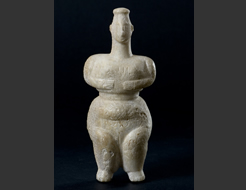|
||||||||||||||||||||||||||||||||
|
|
Museum of: Athens | |||||||||||||||||||||||||||||||
| Name of the artefact: Marble female figurine | ||||||||||||||||||||||||||||||||
|
Marble, female,steatopygic figurine, standing in a
severe position with a polos on her head. The latter as well as the
incised symbols on her shoulders may indicate a goddess or a
priestess. |
||||||||||||||||||||||||||||||||
|
WHERE IS IT AND MAIN
CHARACTERISTICS |
STATE |
|||||||||||||||||||||||||||||||
|
Department: |
Prehistoric |
Preservation: |
Very good | |||||||||||||||||||||||||||||
|
Inventory number: |
3928 |
Restauration: |
No restored | |||||||||||||||||||||||||||||
|
Name of the artefact: |
Marble female figurine |
Completeness: |
Complete | |||||||||||||||||||||||||||||
|
Object type: |
Human figurine |
|||||||||||||||||||||||||||||||
|
Material: |
Marble |
|||||||||||||||||||||||||||||||
|
Methof of manufacture: |
Sculptured |
|||||||||||||||||||||||||||||||
|
Decoration
type: |
Incision |
|||||||||||||||||||||||||||||||
|
Distinctive mark: |
The incisions |
|||||||||||||||||||||||||||||||
|
DIMENSIONS |
PERIOD OF USE |
|||||||||||||||||||||||||||||||
|
Length (mm): |
- |
Epoque: |
Neolithic |
|||||||||||||||||||||||||||||
|
Heigth
(mm): |
15 |
Culture: |
- |
|||||||||||||||||||||||||||||
|
Diameter
(mm): |
- |
Period: |
Early Neolithic |
|||||||||||||||||||||||||||||
|
Width (mm): |
62 |
Face: |
- |
|||||||||||||||||||||||||||||
|
Thickness (mm): |
- |
Absolute chronology: |
6500-5300 BC |
|||||||||||||||||||||||||||||
|
Weight
(g): |
- |
|||||||||||||||||||||||||||||||
DISCOVERY |
||||||||||||||||||||||||||||||||
|
Date: |
1891 |
Country: |
Greece |
|||||||||||||||||||||||||||||
|
District: |
Peloponnese |
Town hall affiliation: |
Sparta |
|||||||||||||||||||||||||||||
|
Village: |
Outskirts of Sparta |
Discovery findspot: |
Neolithic settlement |
|||||||||||||||||||||||||||||
|
Condition of discovery: |
Archaeological excavation |
Discovery type: |
Deposit |
|||||||||||||||||||||||||||||
|
ANALYSES – DETERMINATIONS |
FILLED IN BY |
|||||||||||||||||||||||||||||||
|
Type: |
- |
Name: |
Alexandra Christopoulou |
|||||||||||||||||||||||||||||
|
Laboratory: |
- |
Institution: |
National Archaeological Museum -
Greece |
|||||||||||||||||||||||||||||
|
No./Code: |
- |
Date: |
21/11/2005 |
|||||||||||||||||||||||||||||
|
DEEPENINGS |
||||||||||||||||||||||||||||||||
|
Morphology of the object: |
||||||||||||||||||||||||||||||||
|
This intact figurine renders a female figure in severe
stance. There is a distinct tripartited division. The head is set on a
tall, strong erect neck. The facial features, mouth, nose, eyes, eyebrows
and ears have been rendered by modelling. Instead of hair on top of the
head there is a discoid covering; it is called ‘polos’, a kind of a ritual
hat which is found in representations of goddesses or priestesses in later
times. The upper part of the body is straight and severe. Geometric in
outline, it is enclosed by the arms folded but not overcrossed on the
chest, below the breasts. The fingers are broadly rendered with few
horizontal incisions. The waist is quite slim compared to the size of the
figurine and definatelly separates the upper from the lower part of the
body. The lower part of the body, in contrast to the upper, is fleshy,
very feminine and juicy. The belly is protruded and a hole in the middle
of it indicates the belly button. The hips are highly modelled, as to give
the impression that the woman could be seated and not standing. The latter
could be strengthened by the disproportionally very short below the knees
legs. |
||||||||||||||||||||||||||||||||
|
Decoration: |
||||||||||||||||||||||||||||||||
|
Some red pigment traces on the face and pubic triangle
would indicate that the figure had painted decoration, like the clay
figurine from Sesklo (photo no.5941). However, the incised decoration on
this marble figurine is its basic characteristic. On the shoulders there
have been incised zig-zag lines on the right and on the left encapsulated
lonzenges with parallel sides. These marks could be simple decorative;
they could also be decorative tatoos or they could indicate a kind of
script. |
||||||||||||||||||||||||||||||||
|
Inscription: |
||||||||||||||||||||||||||||||||
|
- |
||||||||||||||||||||||||||||||||
|
Analogies: |
||||||||||||||||||||||||||||||||
|
The production of figures during the early and middle
neolithic periods is mainly constituted of clay female figurines. Marble
as material for figurines was used later, in the late and final neolithic
periods. Thus, this figurine from Sparta is among the unique neolithic
objects in Greece that are made from marble and date to 6500-5300BC. At
the same place with this figure, three more marble female figurines were
found, much smaller in size. Unknown, however, remains if these products
were locally made or were brought by trade from another place. |
||||||||||||||||||||||||||||||||
|
Interpretation: |
||||||||||||||||||||||||||||||||
|
Τhe modeling of the female figurines during the Early
and Middle Neolithic period (6500-5300 BC ) present some typical
characteristics; these are the profound naturalism, the pronounced masses
of breasts, buttocks, belly and thighs (photo no 16500), the richness in
the hairdressing (photos no 16398, 16385, 16397) and the variety of their
position (photos no 16479, 16475, 16488). Although no cult places have
been identified with certainty in the neolithic settlements, all these
figurines have been interpreted as divine creatures, since woman was the
life source of neolithic man. Another interpretation wants these figurines
as educational / communicative means for the whole community, something
like ‘photographic’ presentation of women in connection with their basic
roles, those of pregnancy, giving birth and suckling. This marble
figurine, compared with the others, has got not only the feminine traits
but also the severe attitude, the straight posture with the hands folded
below the breasts, the ornaments on the arms and the head covering as well
as the careful workmanship. All these point to the artist’s wish to create
not simply a distinct female figure, but a Goddess. |
||||||||||||||||||||||||||||||||
|
Bibliography: |
||||||||||||||||||||||||||||||||
|
- |
||||||||||||||||||||||||||||||||

